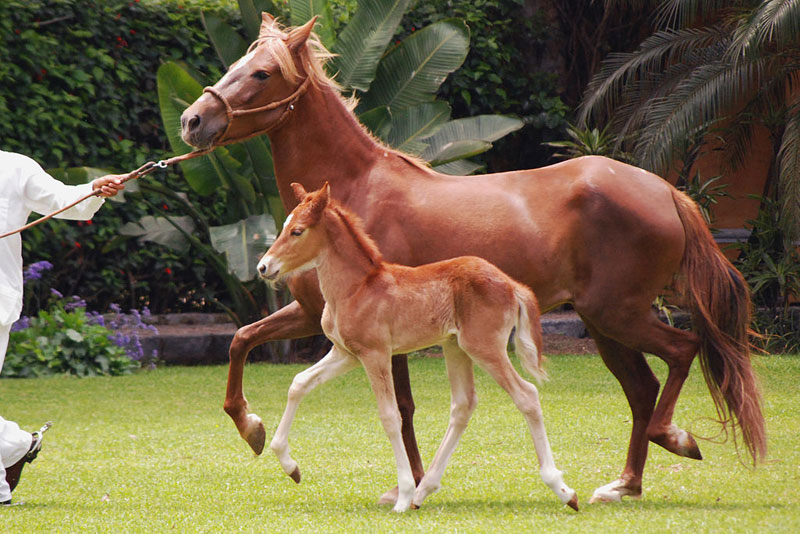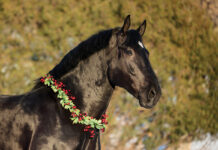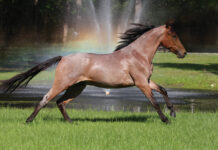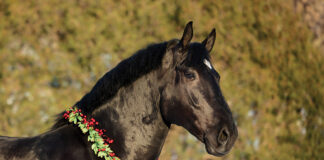The Peruvian Horse, previously known as the Peruvian Paso, was developed for one reason: to provide riders with the smoothest and most comfortable ride as they covered miles of expansive haciendas (plantations). While the distinctive lateral four-beat gait was paramount, and is passed on to every foal, equally important to early breeders was disposition and brio, the breed’s spirit. Today, the Peruvian Horse continues to combine intelligence and a willing work ethic with confidence and an elegant presence, resulting in a versatile horse that does well in many activities.

Tapping Spanish Roots
More than 400 years ago, the conquistadors brought to Peru the horses that would become the country’s national treasure. Combining blood from the African Barb and the Andalusian to provide stamina, strength, action and carriage with the temperament and smooth gait from the Spanish Jennet, the Peruvian Horse was selectively bred for centuries in its native country. Peru’s geographic isolation and natural boundaries, which made it difficult to bring in horses, helped retain the purity of the original bloodlines.
Peruvians in America
While Peru has enjoyed and honored its national horse for centuries, American riders discovered the Peruvian Horse only about 50 years ago.
During the five decades that the Peruvian Horse has been in the U.S., there have been a total of about 30,000 horses (both domestically bred and imported) registered in the various studbooks. At this time, it is estimated that there are approximately 14,000 horses living in the U.S. In comparison, nearly 30,000 Peruvian Horses are living in their native country.
Conformation and Appearance
The Peruvian Horse is strikingly handsome, standing between 14 and 15 hands tall, with a few individuals under or over the average height. “While Peruvian Horses may initially appear to be slightly smaller than some other riding horses, their strength and energy give the rider a much bigger feel,” says Danell Adams, president of the North American Peruvian Horse Association (NAPHA).
It’s important to understand that the Peruvian Horse is a light horse, meaning that it was developed to be a horse of moderate height, size and weight suitable for its purpose of covering long distances in gait easily and efficiently.
Long manes and forelocks complement arched necks, which lift as the horses transition from the walk to their distinctive four-beat lateral gait. While the solid colors of bay, black, chestnut, brown and gray are considered most desirable, Peruvian Horses can be found in nearly any color. White markings on the legs and face are accepted.
The Peruvian Gaits
Only the Peruvian Horse performs the paso llano, its trademark four-beat gait. When executed correctly, it’s an extremely smooth gait with excellent ground-covering ability due to its extension (forward reach of the front legs) and over-reach (forward reach of the rear legs), where the hind hoofprints easily match or overlap the front hoofprints.
The paso llano is the most efficient and comfortable gait for both horse and rider, and properly conditioned horses can cover long distances with ease in this gait.
“With three feet on the ground at all times in the paso llano gait, the ride is smooth, and without the jarring of the trot, the side-to-side motion of the pace, or the big motion of the canter,” says Edie Gandy, former president of the NAPHA, as well as a judge and breeder. “As the horse moves into the faster sobreandando, the gait becomes slightly more lateral, but still with four distinct beats.” The sobreandando, which is similar to the rack in other gaited breeds, may be asked for when greater speed is needed for a short period of time. Like the canter or gallop, it’s not meant to be used as the primary gait or for long periods.
Another gait performed by the Peruvian Horse is a true pace, called huachano. As this gait is not unique to the breed, it is not demonstrated in breed events.
In executing the gaits, Peruvian Horses exhibit termino—the outward swinging of the front legs from the shoulders. This graceful and eye-catching movement is unique to the Peruvian Horse, and the height of termino depends on the individual horse.
|
Human Connection
In addition to its Cadillac-smooth ride, which is a great boon for older riders and those with joint issues, the Peruvian Horse wants to work with people and thrives on a mutually respectful and kind partnership.
“One of the things I love most about Peruvian Horses is that whatever we want to do, they want to do it with us,” says Julia Mann, a junior rider from California. “They want to work with you all day long.”
Versatility
“The Peruvian Horse is a versatile horse that also shows, not a show horse that is also versatile,” says Adams. She estimates that about 20 percent of the Peruvian Horses registered with the NAPHA compete in recognized horse shows.
In addition to competitions, Peruvian Horses excel in trail riding, are often ridden in exhibitions and parades, and are used for various aspects of farming and ranching. Properly prepared and conditioned horses successfully participate in long-distance riding events as well.
While the breed can do just about anything, most riders and trainers focus on the capabilities of the breed’s rare and beautiful natural gait.
In the Show Ring
Peruvian Horses compete in two basic divisions: performance and breeding/luxury. Performance classes include western and English pleasure, as well as classes where the horse and rider maneuver through cones to demonstrate the horse’s smoothness, willingness and ease of handling.
“Performance classes are judged on the complete picture of horse and rider,” says Adams. “Breeding classes, on the other hand, are judged on the horse’s conformation and gait [to determine] the best breeding stock of the Peruvian Horse. As such, breeding classes are limited to mares and stallions. Geldings compete in the luxury classes, which showcase the temperament, beauty, intelligence, gait and work ethic that Peruvians are known for.”
Adventures Outside the Arena
Jody Childs, a former hunter/jumper rider and trainer in San Diego, Calif., had worked with everything from Appaloosas to warmbloods before she discovered the Peruvian Horse in 2002. “I was looking for a horse for a client when I stumbled upon a yearling palomino Peruvian gelding,” she says. “In him, I found a horse with a strong connection to humans, loyalty, bravery and willingness I’d not seen in other breeds.”
A few years later, Childs had a wonderful gelding, but breed shows weren’t right for him. “A friend suggested we try one of the rides put on by the American Competitive Trail Horse Association (ACTHA), and pretty much on a whim, I entered us in a local competitive trail riding event. We placed second that day, which I credit to my horse’s willingness to try new things and his bravery—traits common to this breed.”
After this auspicious beginning, Childs was hooked, and in 2010, she attended 10 ACTHA rides, which resulted in her gelding winning the NAPHA National High Point Trail Horse award. In 2011, the ACTHA produced a TV show called America’s Favorite Trail Horse, for which 1,000 horses auditioned and 100 horses were chosen. Two Peruvians made the cut, one of which was Childs’ gelding.
The Peruvian as a First Horse
Childs is passionate about helping adult riders discover the joy of riding, courtesy of the Peruvian Horse’s people-pleasing personality, level-headed intelligence and smooth gait.
“The psychology of the Peruvian Horse is different,” says Childs. “They tend to stay calm in the midst of stressful events and evaluate the situation. Even if they spook, they remain present with the rider. I believe this quality adds a measure of safety that is even more important with mature riders.”
A Multitude of Possibilities
With a foundation of Old World bloodlines and generations of careful breeding, today’s Peruvian Horses exhibit pride, versatility and excellence in performance. Whether it’s as a youth mount, family horse, trail horse, or a performer in the show-ring or on the parade route, the Peruvian Horse offers something for nearly every rider.
Resources
- North American Peruvian Horse Association
www.napha.net - United States Peruvian Horse Association
www.uspha.net
This article originally appeared in the August 2014 issue of Horse Illustrated magazine. Click here to subscribe!






Beautiful Horses!!
cool
I went and saw these horse yesterday at a horse fair. I fell in love with the breed!
Nice.